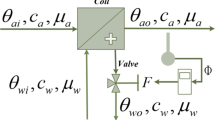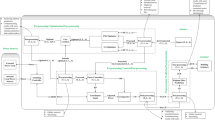Abstract
In energy management system (EMS), the scheduling of air-conditioning (AC) system has been shown to reduce considerable amount of its power consumption with relatively low implementation cost. However, most scheduling methods lack a systematic approach to ensuring optimal power consumption reduction and comfort experienced by occupants. The main contribution of this paper is a new optimized AC scheduling approach that focuses on indoor thermal comfort using a new multi-objective optimization algorithm, called the improved global particle swarm optimization (IGPSO), which able to find better optimal solutions faster than its original version, the global particle swarm optimization (GPSO) algorithm. IGPSO is used to model the building characteristics and to find optimum indoor temperature values for the room/building. The proposed technique is based on predicted mean vote (PMV) comfort index that is able to reduce AC power consumption while maintaining indoor comfort throughout its operation. The schedule is set in advance by making use of weather forecast and the estimation of building characteristic parameters. This technique can be implemented on existing buildings with existing HVAC systems with minimal modifications to the HVAC infrastructure. Experimental results show that the proposed method is able to provide good PMV while consuming less power compared to the commonly used extended pre-cooling technique.



















Similar content being viewed by others
Abbreviations
- a 1, a 2, a 3 :
-
Coefficients for building characteristic for tstart
- b 1, b 2 :
-
Coefficients for building characteristic for tstop
- C 1, C 2, C 3 :
-
Acceleration coefficients
- F i :
-
Particle’s fitness at the ith iteration
- f cl :
-
Clothing surface area factor
- h c :
-
Convective heat transfer coefficient
- I cl :
-
Clothing insulation
- i :
-
Iteration
- K 1 :
-
1st objective’s maximum particle fitness
- K 2 :
-
2nd objective’s maximum particle fitness
- M :
-
Metabolic rate
- N :
-
Number of particles
- NA :
-
Number of archived particles
- n :
-
Item in population
- p a :
-
Water vapor partial pressure
- RH :
-
Relative air humidity
- R 1, R 2, R 3 :
-
Uniform-distributed random numbers between 0 and 1
- r D :
-
Random integer from 1 to D
- r i :
-
Random integer from 1 to i
- r N :
-
Random integer from 1 to N
- T air :
-
Air temperature
- T cl :
-
Clothing surface temperature
- T final :
-
Final Tair
- T initial :
-
Initial Tair
- T mrt :
-
Mean radiant temperature
- T out :
-
Outdoor air temperature
- T SP :
-
Setpoint temperature
- t operative :
-
AC system full operating duration
- t start :
-
Early-on duration
- t stop :
-
Early-off duration
- V i :
-
Particles velocity at the ith iteration
- v ar :
-
Relative air velocity
- W :
-
Electrical power consumption
- W m :
-
Effective mechanical power
- X i :
-
Particle position at the ith iteration
- \( {X}_i^A \) :
-
Archived particle position at the ith iteration
- \( {X}_i^G \) :
-
Particle’s global best position at the ith iteration
- \( {X}_i^L \) :
-
Particle’s local best position at the ith iteration
- x i :
-
ith optimization variable
- γ :
-
Improvement factor
- \( {\gamma}_i^n \) :
-
Improvement factor of the nth particle at the ith iteration
- ε σ :
-
Standard deviation error
- σ AF :
-
Particle’s standard deviation
- σ AF :
-
Archived particle’s standard deviation
- φ :
-
Coefficient acceleration factor
- φ i :
-
Coefficient acceleration factor for the ith iteration
References
Aherne, V. and Henderson, M. (2015). Optimising your heating, ventilation and air conditioning systems. Office of Environment and Heritage, pp. 1–109.
Alajlan, S. A., Smiai, M. S., & Elani, U. A. (1998). Effective tools toward electrical energy conservation in Saudi Arabia. Energy Conversion and Management, 39(13), 1337–1349.
Andrew, K., Guanglin, X., & Zijun, Z. (2014). Minimization of energy consumption in HVAC systems with data-driven models and an interior-point method. Energy Conversion and Management, 85(1), 146–153.
Atthajariyakul, S., & Leephakpreeda, T. (2005). Neural computing thermal comfort index for HVAC systems. Energy Conversion and Management, 46(15–16), 2553–2565.
Biao, Y., Enshen, L., & Xi, M. (2015). Dynamic thermal reaction analysis of wall structures in various cooling operation conditions. Energy Conversion and Management, 105(1), 872–879.
Bradshaw, V. (2006). Chapter 1 human comfort and health requirements. The building environment: Active and passive control systems, 3rd edition. May 1.
Braun, J. E. (1990). Reducing energy costs and peak electrical demand through optimal control of building thermal storage. ASHRAE Transactions, 96(2), 876–888.
Chalermchaiarbha, S., & Ongsakul, W. (2013). Stochastic weight trade-off particle swarm optimization for nonconvex economic dispatch. Energy Conversion and Management, 70(1), 66–75.
Chunxia, F., & Youhong, W. (2008). An adaptive simple particle swarm optimization algorithm. In 2008 Chinese Control and Decision Conference, (pp. 3067–3072). Yantai, Shandong.
Electricity Tariff Schedule 2011. Tenaga Nasional Berhad, pp. 1–5.
EL-Naggar, K. M., AlRashidi, M. R., & Al-Othman, A. K. (2009). Estimating the input–output parameters of thermal power plants using PSO. Energy Conversion and Management, 50(7), 1767–1772.
Fanger, P. O. (2007). Thermal comfort: Analysis and applications in environmental engineering. University of Michigan: Danish Technical Press.
Fernandez, N., & Katipamula, S. (2012). Energy savings modeling of standard commercial building re-tuning measures: large office buildings. Pacific Northwest National Laboratory, 32(1), 1–60.
Haniff, M. F., & Selamat, H. (2013). Review of HVAC scheduling techniques for buildings towards energy-efficient and cost-effective operations. Renewable and Sustainable Energy Reviews, 27(1), 94–103.
Haniff, M. F., Selamat, H. and Buyamin, S., 2015. An improved global particle swarm optimization for faster optimization process. Jurnal Teknologi 72(2).
Haniff, M.F., Selamat, H., Buyamin, S. Power-comfort optimized scheduling of air conditioning system. In Proceedings of the 16th International Conference on Mathematical and Computational Methods in Science and Engineering (MACMESE ′14) (pp. 99–105). World Scientific and Engineering Academy and Society (WSEAS).
Hu, W., & Li, Z. S. (2007). Simpler and more effective particle swarm optimization algorithm. Ruan Jian Xue Bao(Journal of Software), 18(4), 861–868.
Huang, W. Z., & Zaheeruddin, M. (2006). Dynamic simulation of energy management control function in VAC-HVAC systems. Energy Conversion and Management, 47(1), 926–943.
Inthachot, M., & Supratid, S. (2007). A multi-subpopulation particle swarm optimization: A hybrid intelligent computing for function optimization. In Third International Conference on Natural Computation (ICNC 2007), (pp. 679–684). Hainan, China: IEEE. 24–27 Aug.
Ismail, F. S., Yusof, R., Khalid, M., Ibrahim, Z., & Selamat, H. (2012). Performance evaluation of self organizing genetic algorithm for multi-objective optimization problems. International Journal of Research and Surveys ICIC-Express Letters, 6(1), 1–8.
Jamian, J. J., & Abdullah, M. N. (2014). Global particle swarm optimization for high dimension numerical functions analysis. Journal of Applied Mathematics, 2014, 1–14.
Jordehi, A. R. (2016). Time varying acceleration coefficients particle swarm optimisation (TVACPSO): A new optimisation algorithm for estimating parameters of PV cells and modules. Energy Conversion and Management, 129(1), 262–274.
Joseph, C. L., Kevin, K. W. W., & Liu, Y. (2008). Sensitivity analysis and energy conservation measures implications. Energy Conversion and Management, 49(11), 3170–3177.
Kennedy, J., & Blackwell, T. (2007). Particle swarm optimization. Swarm intelligence, 1(1), 33–57.
Laurent, Z., Stéphane, L., Daniel, R., & Kamel, B. (2010). Experimental and numerical characterization of thermal bridges in prefabricated building walls. Energy Conversion and Management, 51(12), 2869–2877.
Meral, O. (2013). Determination of optimum insulation thickness based on cooling transmission load for building walls in a hot climate. Energy Conversion and Management, 66(1), 106–114.
Niknam, T., Mojarrad, H. D., & Meymand, H. Z. (2011). A novel hybrid particle swarm optimization for economic dispatch with valve-point loading effects. Energy Conversion and Management, 52(4), 1800–1809.
Power Knot LLC. 2011. COPs, EERs, and SEERs: How efficient is your air conditioning system? USA.
Rahman, M. M., & Rasul, M. G. (2010). Energy conservation measures in an institutional building in sub-tropical climate in Australia. Applied Energy, 87(1), 2994–3004.
Santamouris, M., Dascalaki, E., Balaras, C., Argiriou, A., & Gaglia, A. (1994). Energy performance and energy conservation in health care buildings in Hellas. Energy Conversion and Management, 35(4), 293–305.
Teeter, J., & Chow, M.-Y. (1998). Application of functional link neural network to HVAC thermal dynamic system identification. In IEEE Transactions on industrial electronics (pp. 170–176), vol. 45, no. 1.
Xu, P. & Haves, P. (2004). Peak demand reduction from pre-cooling with zone temperature reset in an office building. In: 2004 ACEEE Summer Study on Energy Efficiency in Buildings (pp. 1–11). August 23–27. Pacific Grove, CA: The Proceedings.
Xu, P., & Haves, P. (2009). Case study of demand shifting with thermal mass in two large commercial buildings. ASHRAE Transactions, 115(2), 586–598.
Yahya, A., Mairna, M., Al-Mashaqbah, S., Kholoud, M., & Mous, M. (2008). Potential of energy savings in the hotel sector in Jordan. Energy Conversion and Management, 49(11), 3391–3397.
Yu, B., Yuan, X., & Wang, J. (2007). Short-term hydro-thermal scheduling using particle swarm optimization method. Energy Conversion and Management, 48(7), 1902–1908.
Zapater, M., & Arroba, P. (2015). Energy aware policies in ubiquitous computing facilities. In O. Terzo & L. Mossucca (Eds.), Cloud computing with E-science applications (pp. 267–286). Boca Raton: CRC Press.
Acknowledgments
The authors would like to thank Universiti Teknologi Malaysia and the Ministry of Higher Education Malaysia for their supports.
Funding
The research is funded by Research University Grant 13H78.
Author information
Authors and Affiliations
Corresponding author
Ethics declarations
Conflict of interest
The authors declare that they have no conflict of interest.
Rights and permissions
About this article
Cite this article
Haniff, M.F., Selamat, H., Khamis, N. et al. Optimized scheduling for an air-conditioning system based on indoor thermal comfort using the multi-objective improved global particle swarm optimization. Energy Efficiency 12, 1183–1201 (2019). https://doi.org/10.1007/s12053-018-9734-5
Received:
Accepted:
Published:
Issue Date:
DOI: https://doi.org/10.1007/s12053-018-9734-5




